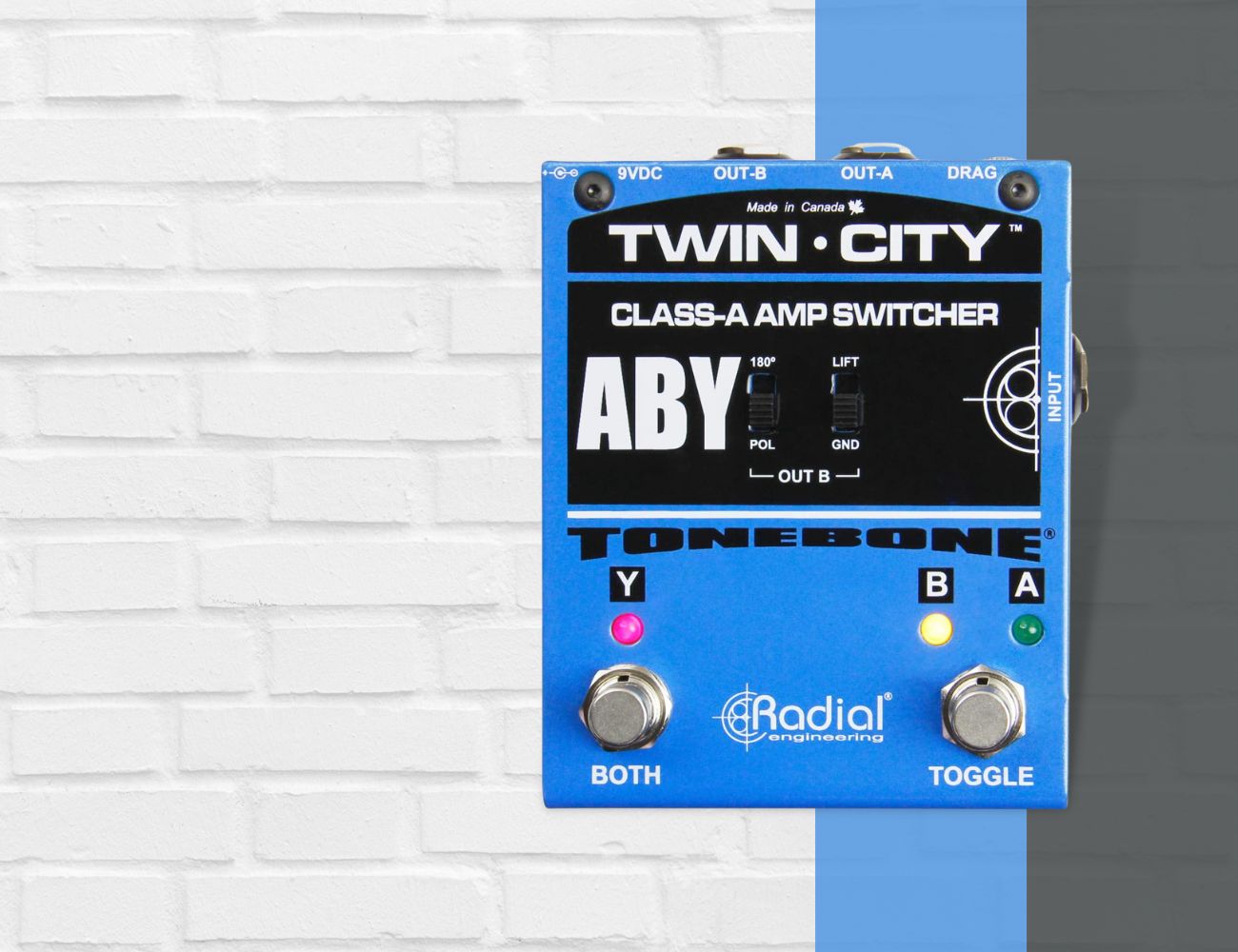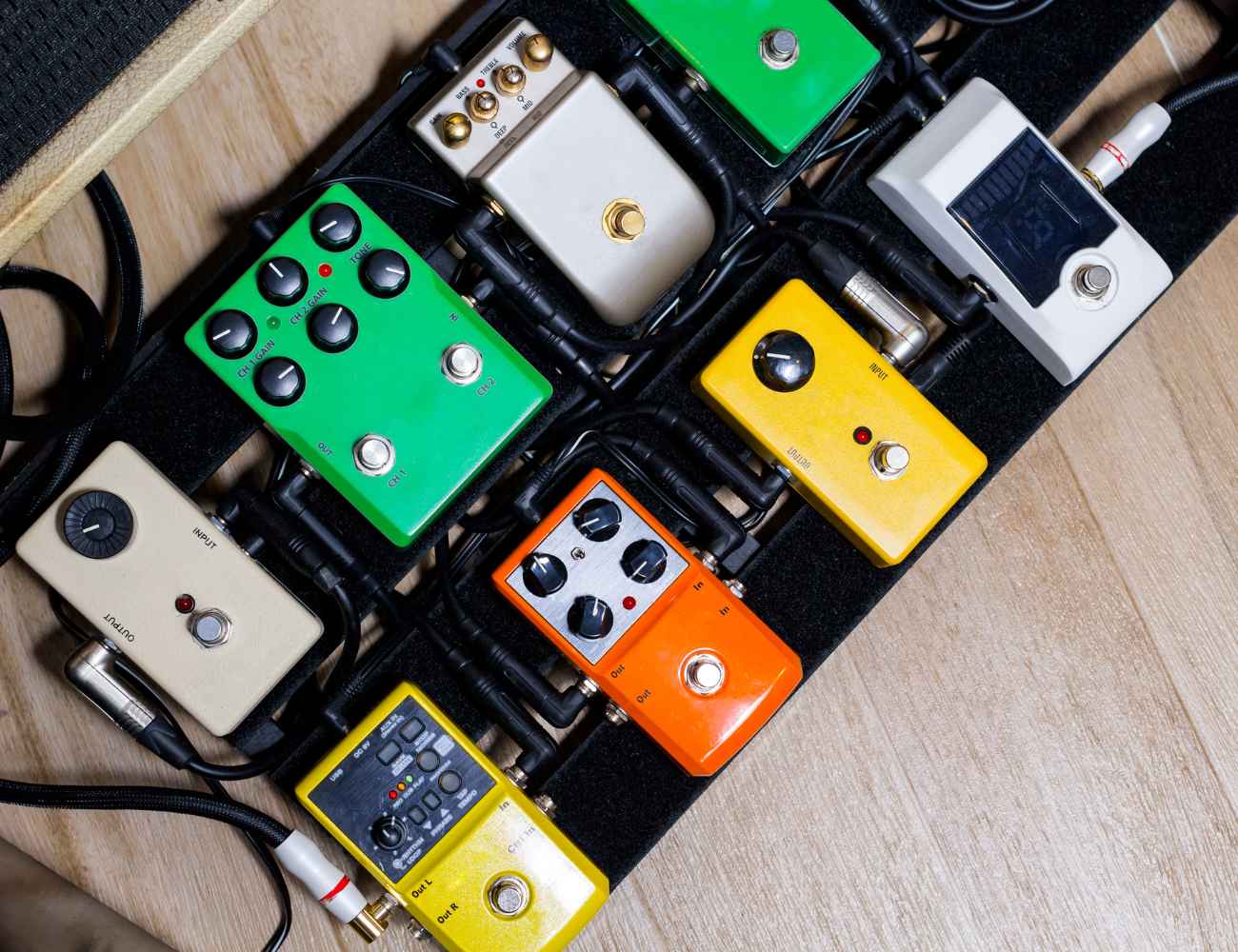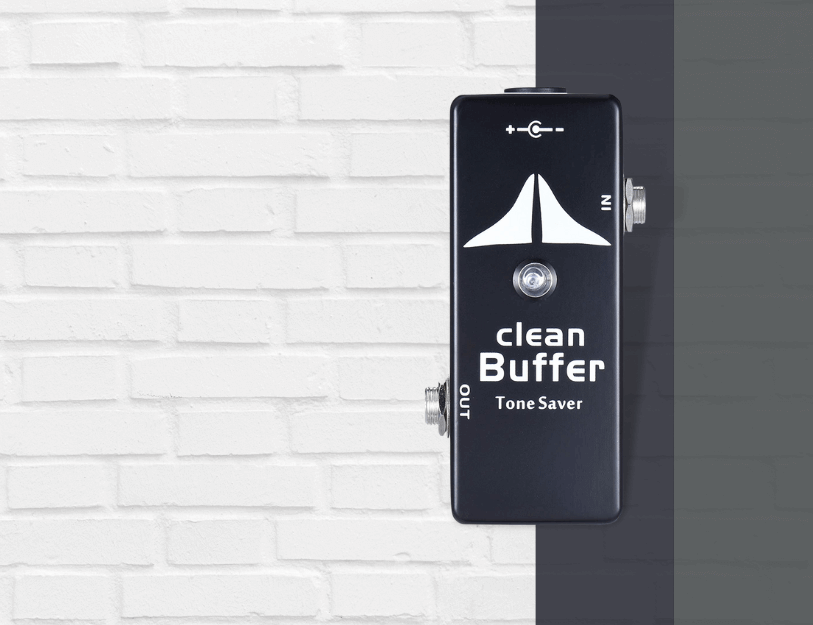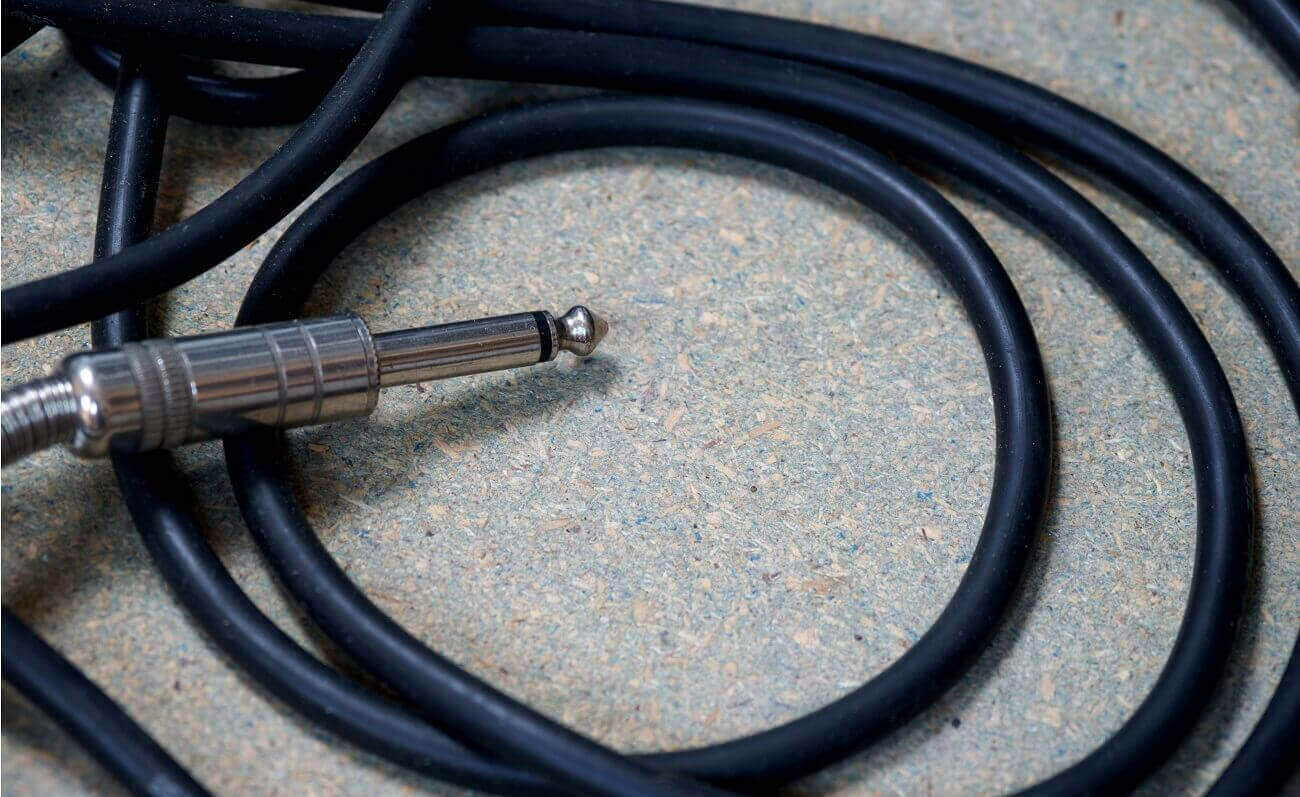You’re jamming away on your guitar when suddenly you feel the urge to switch gears, maybe blend in a bit of that warm tube tone, or get some crunchy distortion, and it hits you: you need an ABY pedal.
Not just any will do, but you’re after the best ABY pedals in the market.
The search can feel like walking in a dense forest with many options, but don’t worry, I’ve got your back.
Understanding how crucial these little devices can be to achieve that seamless transition and maintain your unique sound, we’ve explored the music equipment world for you.
In this article, we’ll navigate you through top-tier ABY pedals, breaking down their features, strengths, and quirks.
Aside from that, I’ll also answer some of the most frequently asked questions on this topic so that you can have a better idea of what to expect.
Table of Contents
- Best ABY Pedals
- What exactly is an ABY pedal?
- What should you consider when choosing an ABY pedal?
- How to properly use an ABY pedal?
- – Familiarize yourself with the controls and features
- – Adjust the parameters to suit your musical goals
- – Incorporate the ABY pedal into your signal chain
- – Calibrate the volume and tone settings on each amplifier
- – Test the ABY pedal in various performance scenarios
- – Consider using a buffered ABY pedal
- – Maintain and troubleshoot your ABY pedal:
- How to order pedals on a pedalboard?
- Boutique vs. Mass-Produced pedals
- How much should you spend on a guitar pedal?
- Can you use a guitar pedal with a bass guitar?
- How to properly power your pedals?
Best ABY Pedals
Before I begin, here are my top selected choices:
Fender ABY Pedal Footswitch Pedal

Fender ABY Pedal Footswitch for enhanced sound versatility. Check Price
|
|
MOOER Micro ABY MKII Channel Switch Pedal

Compact and versatile MOOER Micro ABY MKII switch pedal for seamless signal switching. Check Price
|
Boss FS-6 Dual Foot Switch Pedal
Compact, durable dual footswitch for instrument control.
The FS-6/FS-7 Dual Footswitches from BOSS offer reliable latch and momentary type switching for various musical instruments and more. They are designed for space-saving convenience and feature a robust construction for long-lasting durability.
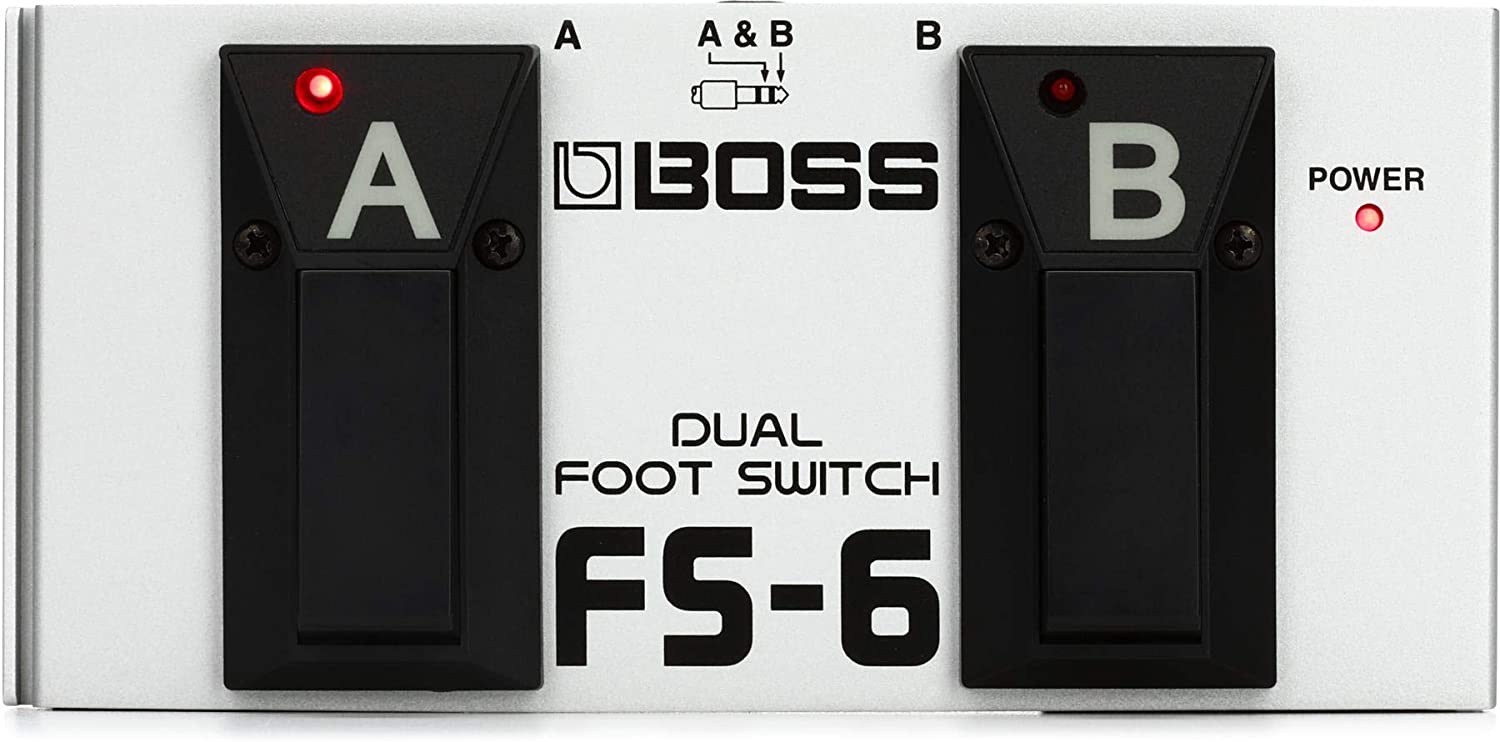
Imagine having the convenience of controlling two functions within one device.
That’s exactly what you get with Boss FS-6 Dual Foot Switch Pedal.
Crafted to cater to the needs of music lovers, this versatile pedal offers a blend of functionality and simplicity.
This handy equipment has two-foot switches packed into one compact unit.
Each switch is completely independent, featuring an LED indicator to ensure you know which function is in play at any given moment.
Furthermore, Boss FS-6 boasts a dual polarity switch, making it a compatible match for almost any gear.
Flexibility is central to the FS-6’s design, allowing you to choose between the latch and momentary modes.
This ensures adaptability to various types of musical equipment, while its battery-powered operation adds a layer of portability for those always on the go.
Also, its rugged design makes it a durable companion for those rigorous jamming sessions.
- My Review
Having given the Boss FS-6 Dual Foot Switch Pedal a whirl, I can confidently attest to its remarkable versatility.
The unit’s two independent foot switches, each with its LED indicator, provide an intuitive experience.
I found this invaluable, as it eliminates any guesswork during a performance.
Right out of the gate, its compatibility is something to commend.
Thanks to the dual polarity switch, it played nicely with all my equipment, making it a true plug-and-play device.
A feature I found particularly striking was the latch and momentary modes.
It’s not every day you stumble upon a pedal that adapts to your setup rather than the other way around.
Speaking of adaptability, the Boss FS- overall design deserves recognition.
Its compactness and battery-powered operation make it a great companion for those always on the move.
This pedal was always ready to go regardless of where I was jamming.
Now, it wasn’t all sunshine and roses.
The pedal’s durability was unquestionable, yet, I found the rugged exterior somewhat abrasive after long hours of use.
This, however, is a minor quibble and doesn’t overshadow the pedal’s high points.
In terms of functionality, the Boss FS-6 delivered beyond expectations.
It performed seamlessly under pressure, and the switches had just the right resistance, providing a satisfying click every time they were engaged.
Here are the ratings I’ll give to the Boss FS-6 Dual Foot Switch Pedal:
Ultimately, the Boss FS-6 Dual Foot Switch Pedal proved adaptable and reliable, striking a commendable balance between complexity and user-friendliness.
While it has room for improvement, it is undeniably a worthy investment for anyone needing a multifunctional pedal.
- Pros:
- Sturdy and durable construction.
- Can be set for latch or momentary operation.
- Allows for dual switching power.
- High-quality and reliable performance.
- Compatible with various musical instruments and devices.
- Cons:
- Battery-powered (9-volt) operation.
- No built-in on/off switch.
- May drain battery if cables are left plugged in.
- Requires a separate TRS short plug for full functionality.
- No AC power or rechargeable option.
My final verdict is that the Boss FS-6 Dual Foot Switch is a highly versatile and feature-rich product with excellent performance.
It is backed by the reputable BOSS brand known for its quality and durability.
While it may have drawbacks, such as battery-powered operation and the need for additional accessories, its overall value is commendable.
With its positive user reviews and strong ratings across different aspects, the Boss FS-6 Dual Foot Switch is a solid choice for musicians seeking reliable and flexible footswitch control.
Old Blood Noise AB/Y Switcher Pedal
Switch between two outputs/inputs with ease with Old Blood Noise AB/Y Switcher.
This AB/Y Switcher from Old Blood allows simultaneous use of two outputs and two inputs. A simple and reliable solution for switching between them.
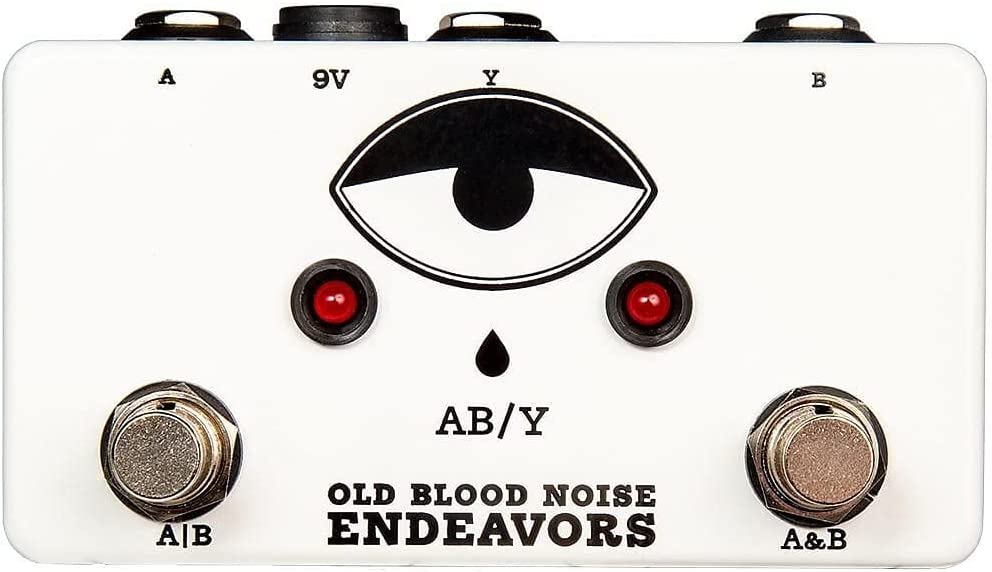
Hailing from Old Blood Noise Endeavors, the Old Blood Noise AB/Y Switcher is a practical piece of gear that embraces simplicity in its design and purpose.
This modest unit takes the conventional idea of an AB/Y Switcher and imbues it with a vintage charm, featuring a classic style and analog signal format.
It’s all about choices and flexibility with this tool.
Want to control two inputs or outputs? No problem.
Need to toggle between them or utilize them simultaneously?
This switcher has got you covered.
While it might not be the stuff of sorcery or groundbreaking innovation, its straightforward operation is part of the appeal.
Running on a 9-volt power supply, this useful addition to the Old Blood Noise Endeavors lineup provides a valuable solution for musicians who crave seamless control over their sound paths.
Though the device might not be flashy, its simplicity and efficacy make it an integral tool for your sound setup.
- My Review
Taking the Old Blood Noise AB/Y Switcher into my hands for the first time, I was immediately struck by its classic, vintage charm.
It’s not often that simplicity and functionality can coexist so elegantly in a single piece of gear, yet here was the perfect example of that balance.
One of my first observations was how this switcher is all about choice.
It offered me the versatility I needed, whether I was controlling two outputs or two inputs.
I found myself valuing the convenience of being able to switch between them with ease.
More impressively, using both at once was equally uncomplicated.
It quickly became clear that this was an overall focus on simplicity, and usability was its greatest strength.
Powering it up with a 9-volt supply was straightforward, and the switcher’s analog signal format resonated with my preference for warmer, more traditional sounds.
But don’t be fooled by its seemingly humble design – it may not look flashy, but it certainly shines in its performance.
But, as much as I admire this switcher, it isn’t without its potential downsides.
Its practical design could be seen as too plain for those seeking something more visually exciting.
And while the switcher’s simplicity is undoubtedly a selling point, I wondered if some users might crave additional features to increase its versatility further.
Despite these minor considerations, I found the Old Blood Noise AB/Y Switch overall a solid, reliable tool in audio gear.
It’s doe not promise the moon and the stars – just good, honest functionality.
Here are the ratings I’ll give to the Old Blood Noise AB/Y Switcher Pedal:
Its charm lies in its simplicity, and it delivers exactly what it sets out to do without any unnecessary bells and whistles.
In a world that often overcomplicates things, finding a device that keeps it simple and effective is refreshing.
- Pros:
- Simple and easy to use.
- Effectively switches between 2 amps/channels.
- High-quality analog signal format.
- Cons:
- Limited additional features or functionalities.
- Potential for signal loss or degradation.
My final verdict is that the Old Blood Noise AB/Y Switcher is a highly versatile and well-performing utility tool.
Its simple yet effective design allows users to seamlessly switch between two outputs or inputs.
The brand, Old Blood Noise Endeavors, carries a good reputation in the industry, further adding to the product’s credibility.
While its feature set may not be extensive, it delivers its intended purpose with a high-quality analog signal format.
Considering its positive reviews and the value it brings to the table, the Old Blood Noise AB/Y Switcher is a solid choice for those seeking a reliable and efficient switching solution.
Orange Amp Detonator Buffered ABY Switcher Pedal
Active ABY switch with silent operation, isolated outputs, and phase switch.
The Radial BigShot ABY is an easy and effective tool for switching between two amps, preserving the original sound quality and eliminating ground hum. It features a blend control for mixing amps for a unique tone.
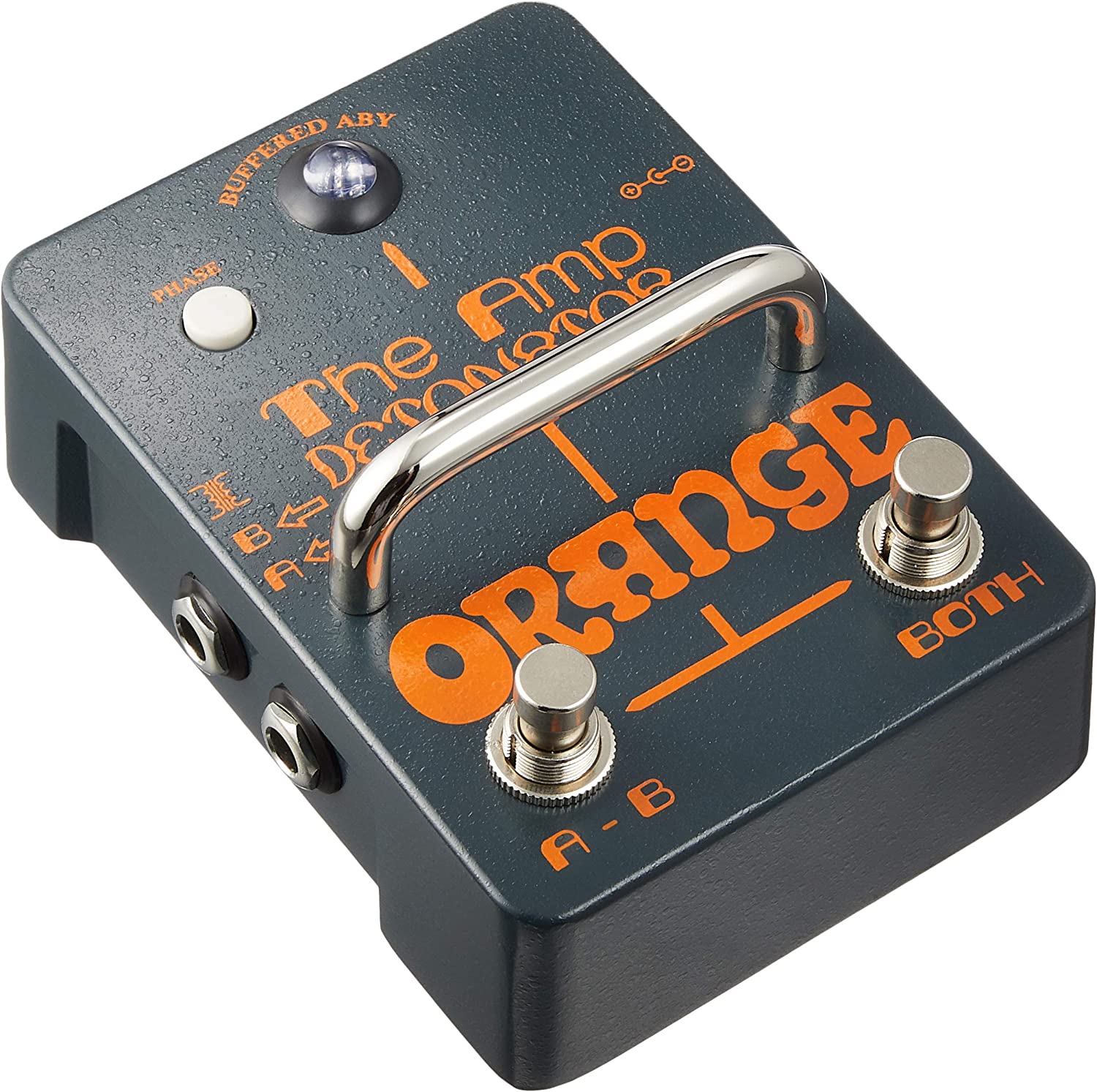
From the world of music comes a unique device known as the Orange Amp Detonator, a guitar effects pedal specially designed to provide you with control and flexibility in sound.
This gadget stands out for its buffered isolated inputs, a key factor in retaining the high frequencies of your audio, especially during extended cable runs.
Besides that, it boasts a phase correction switch, a handy feature for handling amps that are out of phase.
Here’s an interesting fact, the Amp Detonator distinguishes itself as the only active ABY switch that a battery can power, be it a 9V or 12V power supply.
This feature gives you flexibility regarding power sources.
Furthermore, you can enjoy a quiet operation owing to its silent design, with isolated outputs and individual footswitches neatly packed into its compact structure.
Its dimensions are manageable, measuring 6 x 3 x 5 inches, and it weighs just 1 pound.
This device operates at 9 volts and comes from the Orange brand, known for its quality in the music industry.
It even offers a 1-year warranty for peace of mind.
- My Review
Taking a deep dive into the Orange Amp Detonator Buffered ABY Switcher Guitar Effects Pedal, I was first struck by its solid build and compact design.
With a frame measuring 6 x 3 x 5 inches and weighing a mere pound, this device is built with portability and sturdiness in mind.
It doesn’t just stop at the aesthetic appeal.
With its buffered isolated inputs, this pedal can maintain high frequencies, even with long cable runs—a necessary feature for anyone looking to keep their sound crisp and clear, no matter the distance.
On testing it out, I was pleased with the smooth operation of the footswitches, which delivered without any disruptive clicks or pops.
Including a phase correction switch was a welcome addition, demonstrating how it effortlessly manages out-of-phase amps, a common headache that plagues guitarists when using multiple amplifiers.
Power versatility is another strong point.
This ABY switch is the only active one on the market that can run on a battery, 9V, or 12V power supply, giving me the freedom to choose my power source.
Yet, it’s not all roses.
One issue I faced was the inconvenient battery replacement process.
You must unscrew the back of the pedal, which can be bothersome, especially if you’re in the middle of a jam session.
Also, some may find the lack of an OFF or Bypass switch a bit problematic, as it means the device needs to be unplugged when not in use.
While minor aesthetic issues were apparent, such as the uneven finish and crooked chrome stomp bar, they didn’t significantly impact its functionality.
Here are the ratings I’ll give to the Orange Amp Detonator Buffered ABY Switcher Pedal:
Ultimately, despite some flaws, this ABY switcher pedal is a powerful tool in the hands of any guitarist, enabling a world of sonic possibilities with its functionality and flexibility.
The Orange Amp Detonator is a testament to Orange’s commitment to quality and innovation.
- Pros:
- Buffered isolated inputs for maintaining upper frequencies.
- Phase correction switch for addressing out-of-phase amps.
- Can be powered by a battery, 9V, or 12V power supply.
- Silent operation with isolated outputs.
- Individual footswitches for easy control.
- Cons:
- No power supply included.
- No OFF or Bypass switch.
- Difficult access to change the battery.
- Possible design issue with battery replacement.
My final verdict is that the Orange Amp Detonator Buffered ABY Switcher Guitar Effects Pedal is a highly versatile and feature-rich pedal with excellent tone and performance.
The Orange brand is well-regarded, and the value it provides is commendable.
However, the difficulty in accessing and replacing the battery may be a drawback for some users.
It is a solid choice for guitarists seeking reliable amp-switching capabilities.
JHS Mini A/B Box Pedal
Swap instruments & amps, mute sound, save space with the JHS Mini A/B Box Pedal.
The Mini A/B is a versatile footswitch for quickly swapping between amps, guitars, and other instruments. This small but powerful device also makes an ideal mute switch for the stage or studio.
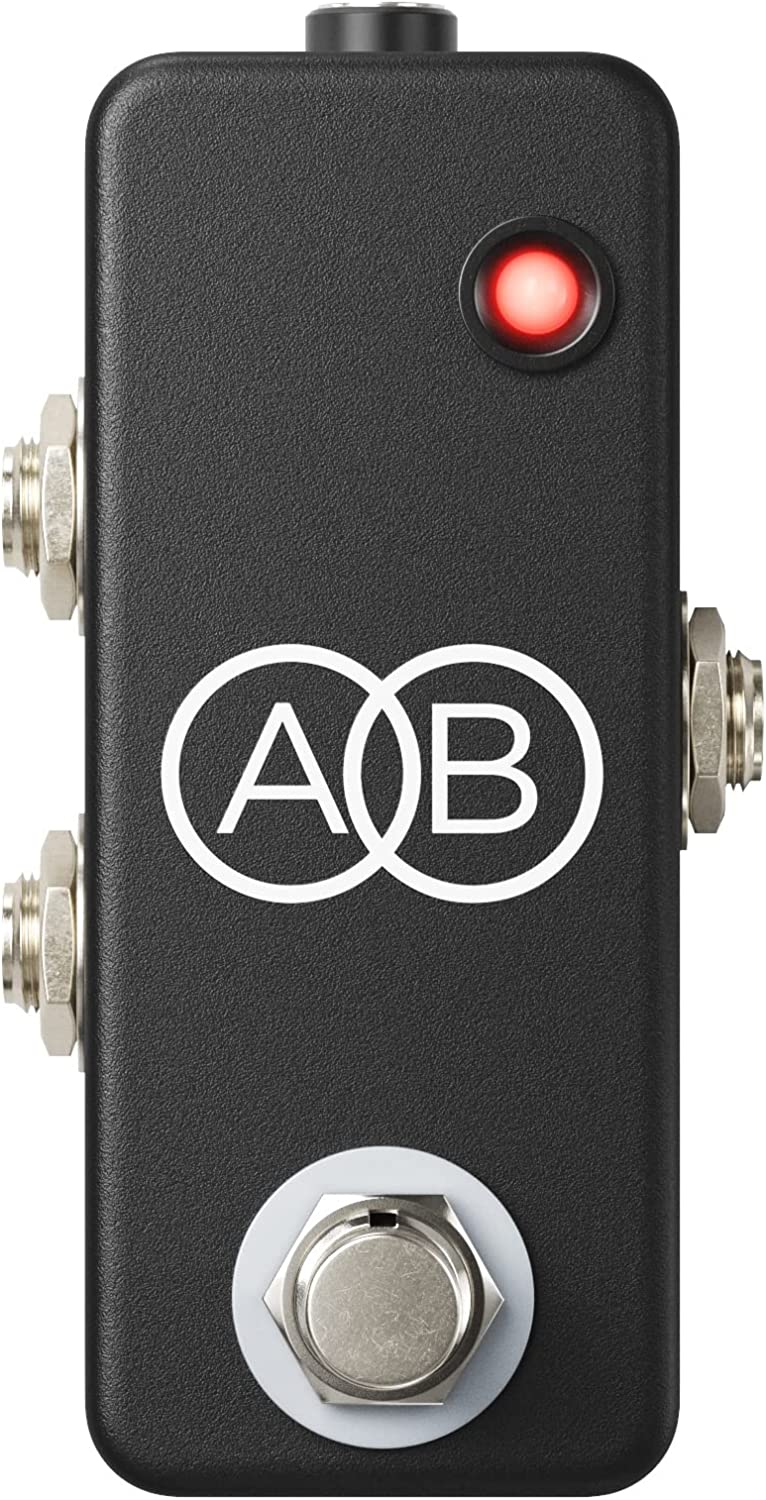
This neat little pedal, brought to us by JHS Pedals, offers a world of versatility for guitarists.
Housed in a compact silver and black box, it makes an easy addition to any pedalboard, regardless of how tight the space is.
Its function? Seamlessly swapping between two instruments or even between two amplifier rigs.
With a pair of quarter-inch jacks on one side, you can swiftly switch inputs without interruptions.
Yet, there’s more to this pedal than simply swapping instruments or amplifiers.
Combined with a tuner, it can help you tune your instrument on stage in silence – a truly handy feature for live performances.
Alternatively, leaving the output unplugged provides a useful mute function.
As for its power requirements, this tiny tool operates on 9 volts.
The JHS Mini A/B Box Pedal is a brilliant tool for any guitarist’s setup.
- My Review
Right from the start, I was struck by the pedal’s streamlined design and compact size, which fit seamlessly into my already crowded pedalboard.
Sporting a silver and black color scheme, it had the function and a sleek look to match.
I appreciated how it allowed me to switch smoothly between two different inputs without any hiccups or unwanted noises, whether it was two guitars or dual amplifier setups.
In addition to these switchovers, I found it particularly useful during tuning sessions.
With this pedal, I could isolate my tuner from the rest of the signal chain, allowing me to tune silently during performances – an absolute boon when you’re on stage.
It became an unexpected lifesaver, as an unplugged output served as a quiet, efficient mute function.
Powering it up was never an issue, thanks to its 9-volt requirement.
While using it, I observed that its footswitch design was simple and incredibly reliable, something I have grown to expect from JHS Pedals.
This feature was much appreciated during those high-pressure live performances when every second counts.
My only quibble with the Mini A/B box was the LED indicator.
It took a while to get used to the color distinction between the A and B settings, as there was no clear marking on the pedal.
Here are the ratings I’ll give to the JHS Mini A/B Box Pedal:
Plus, I noticed occasional noise when switching from one channel to another.
But, this was infrequent and not a significant hindrance.
- Pros:
- Simple and straightforward design
- Allows instant switching between two instruments
- Useful for switching tones on dual amplifier rigs
- Can isolate tuner from signal chain for silent tuning
- Convenient mute function when output is unplugged
- Cons:
- Output jack may become temperamental over time
- Some users experienced noise issues when switching channels
- Loud click or pop sound when switching channels
- Inadequate customer support experience for some users)
- Occasional reports of the product not working properly
My final verdict is that the JHS Mini A/B Box Pedal is a solid choice for musicians seeking a simple and reliable solution for instrument switching and tone control.
Its compact size and versatile features offer convenience and flexibility for live performances, studio recordings, and home setups.
While there have been some reported issues with output jacks and noise, the overall positive feedback regarding its functionality, build quality, and the reputable JHS brand makes it a worthwhile investment.
Considering its reasonable pricing, this pedal provides good value for guitarists and musicians in need of a compact A/B box.
Fender ABY Pedal Footswitch Pedal
Fender ABY Pedal Footswitch for enhanced sound versatility.
Fender is a renowned music brand with over 70 years of history, offering quality instruments and amps to musicians around the world. They strive to exceed the expectations of music enthusiasts with their spirit of rock-n-roll.
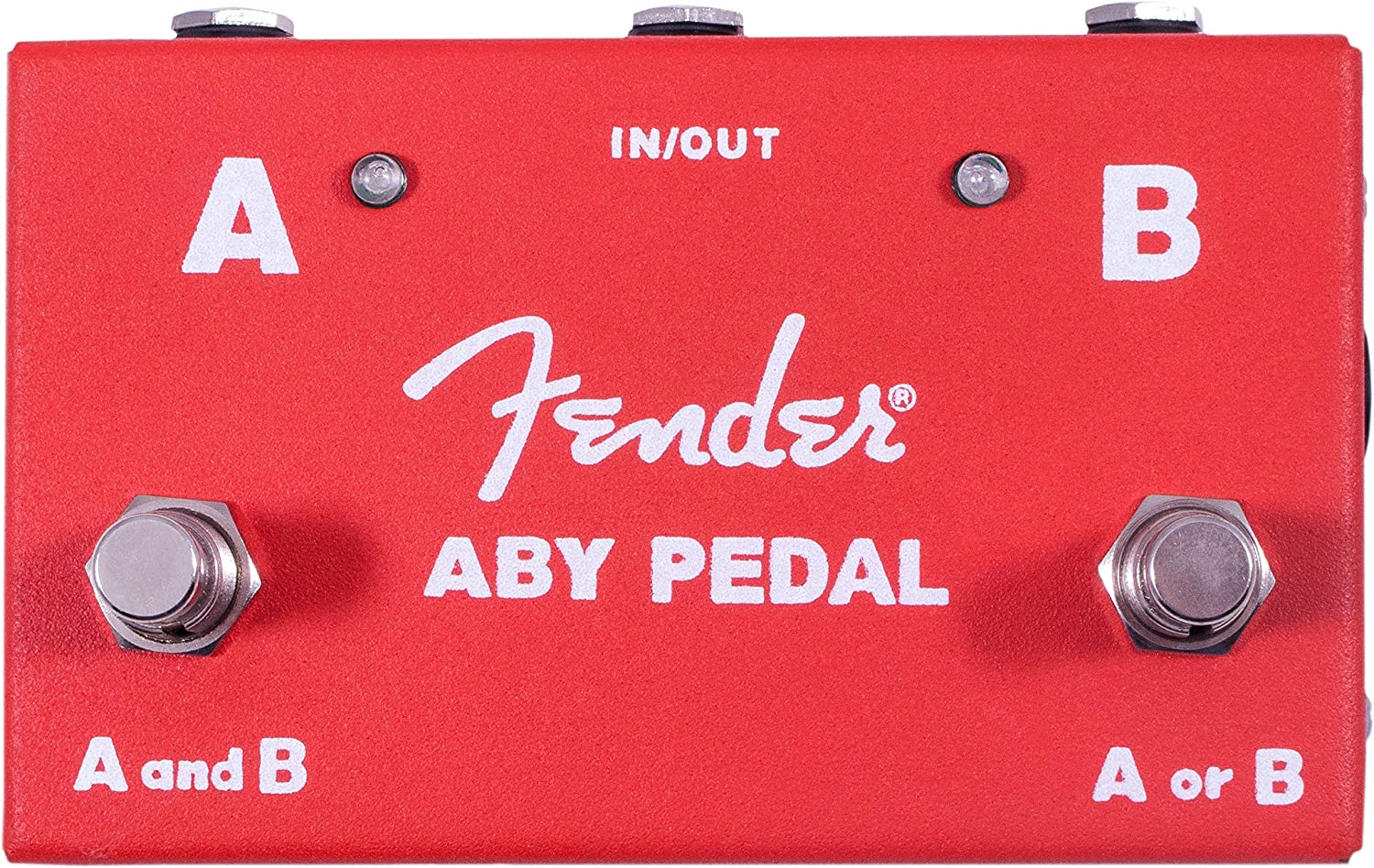
So, picture this: a footswitch made by Fender decked out in red and crafted from durable metal.
It’s compact, just about 7.48 inches deep, 11.42 inches wide, and 3.54 inches high, and it’s surprisingly light, weighing in at only a quarter of a pound.
This little pedal is pretty versatile; it’s been designed specifically to work with your guitar.
Its real charm lies in its practical functionality.
It provides hardwire bypass when not in use, ensuring your guitar’s natural tone remains unaltered.
But what’s cool is how it offers two switching options: “A or B” and “A and B.” It allows you to create unique soundscapes by experimenting with your rig setup.
Oh, and did I mention the LED illumination?
A 9-volt battery or a power source powers it.
Though primarily for the indicator lights, it certainly adds a rockstar appeal.
But remember, if you want to enjoy the lights, you’ll need to power it up!
- My Review
Let’s dive into the little red dynamo, the Fender ABY Pedal Footswitch.
When I first got my hands on it, I was pretty impressed.
It’s quite a compact unit, lightweight but sturdy.
Metal chassis? That’s a big check.
This thing is built like a tank and ready to endure the rigors of any gig or rehearsal.
Immediately, I admired the pedal’s versatility.
The “A or B” and “A and B” options? Genius.
Overall, controlling the flow of sound through my rig, either splitting between two outputs or routing through both, opened up a vast world of tonal possibilities.
No denying it’s a nifty feature for any gearhead keen on experimenting with their sound.
Yet, there was a caveat.
Once I hooked it up, I noticed something that made me raise an eyebrow. Yep, it was noise.
The pedal, while efficient, seemed to add a noticeable hum.
This wasn’t a deal-break overall, especially for informal sessions, but it could be a bit of a letdown for more professional setups or recording.
Now let’s touch on the LEDs – they’re bright and easy to see, a feature I found genuinely useful, especially during dimly-lit gigs.
However, do they require a separate power source or a 9V battery? A bit of a downer.
A power switch would be a welcome addition, too, to conserve battery life when not in use.
So, there it is.
Here are the ratings I’ll give to the Fender ABY Pedal Footswitch Pedal:
The Fender ABY Pedal Footswitch: a handy, durable tool that brings real value to your setup, especially if you love exploring diverse soundscapes.
However, consider the potential for some background noise and the separate power requirement for the LEDs. It’s a reliable little beast, but like all gear, it’s got its quirks to be aware of.
- Pros:
- Switch between amps or play both simultaneously.
- No signal loss with true hardwire bypass.
- Offers versatility within your rig.
- Durable metal chassis and switches.
- Cons:
- Possible buzz/hum issues.
- Some reviewers experienced noise problems.
- Noisy when using certain configurations.
- LED lights cannot be turned off.
My final verdict is that the Fender ABY Pedal Footswitch offers good versatility and features a durable metal chassis and switches.
However, it may have potential drawbacks, such as some users reporting buzz/hum issues and noise problems.
The lack of an option to turn off the LED lights and the mixed reviews on performance are also worth considering.
Overall, it is a decent product with a reputable brand.
Still, before purchasing, potential buyers should weigh the pros and cons based on their specific needs and preferences.
Radial Engineering Buffered ABY Pedal
Radial Engineering’s Acoustic Guitar Hardware for pristine, noiseless sound.
Twin-City offers guitarists a convenient way to switch between two amps while preserving their tone. The Drag Control feature ensures signal loss compensation and load correction, creating a natural, responsive interaction between guitar and amp.
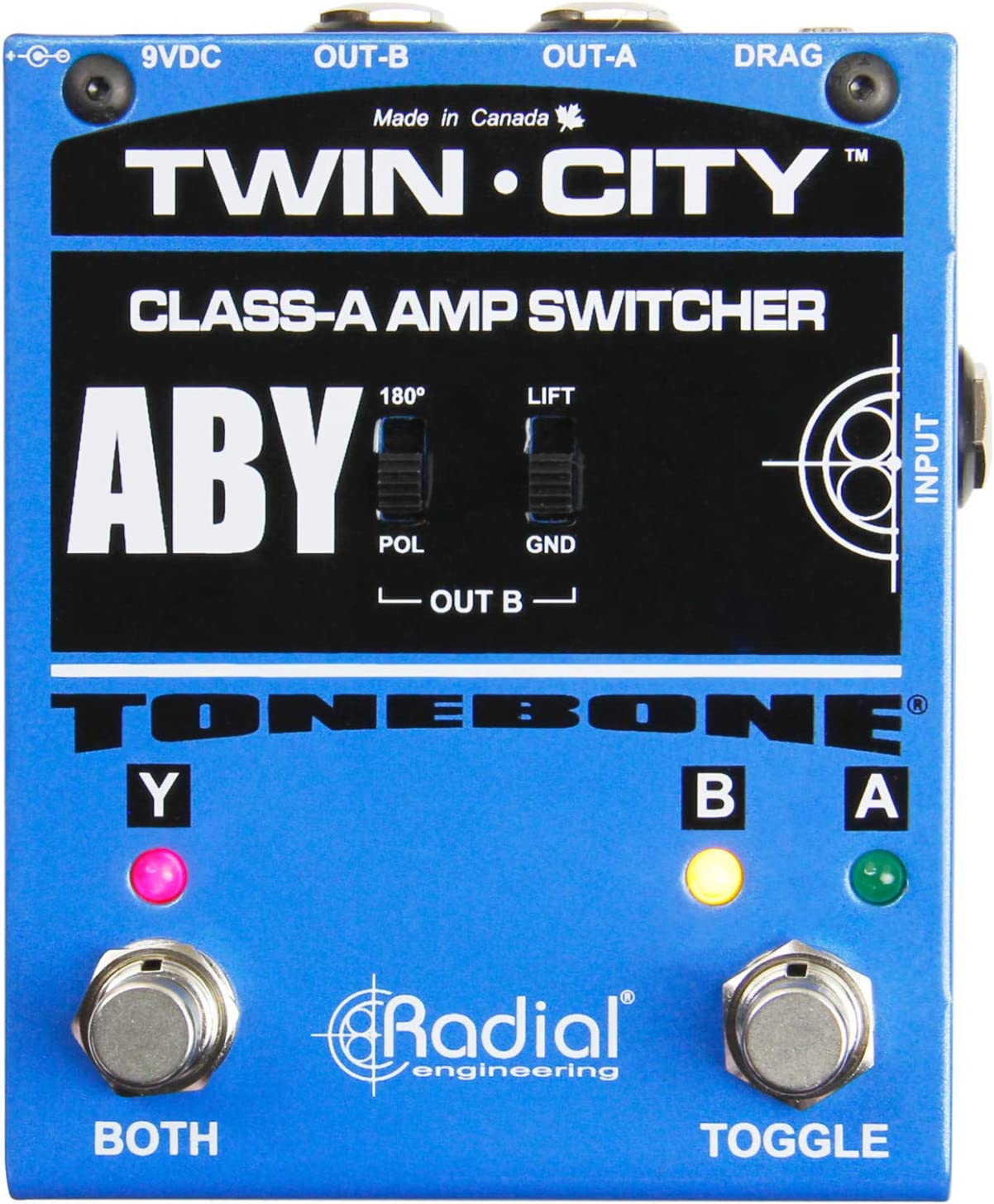
This versatile hardware, designed for guitar enthusiasts, is a buffered ABY switcher, allowing you to connect and drive two amps simultaneously.
It effectively eradicates any noise or loss of gain, ensuring your natural guitar tone remains intact.
This compact device, with dimensions of 5x3x3 inches and weighing only a pound, is designed to fit comfortably on any pedalboard.
It operates via a standard 9-volt power supply, meaning it’s easy to integrate into your setup.
Its isolated output feature is key in eliminating any undesirable hum or buzz from your audio, while the 180-degree polarity ensures both amps are in phase.
An intriguing aspect of this hardware is the Drag Control load correction technology, a feature that Radial Engineering also includes in their acclaimed Radial JD7 Injector.
This offers an almost intuitive experience, adjusting for cable signal loss and mimicking the unique interaction between your guitar and amp.
In blue and crafted with a buffer and acoustic style, this hardware offers a neat package of practical and innovative features.
- My Review
I noticed how the Radial Engineering Acoustic Guitar Hardware (R8007115) fits right onto my pedal board with its compact design.
Weighing only a pound doesn’t add any noticeable heft to my setup, which is always a plus.
I immediately appreciated the buffered ABY feature.
Hooking up two amps and running them together?
That’s a breeze with this little powerhouse.
Interestingly, the hardware doesn’t just eliminate noise but also compensates for any loss of gain.
This was a pleasant surprise since preserving my natural guitar tone is always a top priority.
A major perk is that it does all this without inducing the annoying hum or buzz often associated with dual amp setups.
One feature that particularly stood out was the Drag Control load correction.
Not every day, you find an accessory compensating for cable signal loss.
Not to mention the replication of the intricate interaction between my guitar and amp.
This hardware accomplishes it beautifully.
Operating on a standard 9-volt power supply, I didn’t have to fret over a specific power source.
But it’s worth noting that the unit doesn’t have a power adapter.
Considering the perks, it’s a minor inconvenience and not a deal-breaker, but something to keep in mind.
The icing on the cake? The 180-degree polarity feature.
My amps are now in phase, creating an even better audio experience.
The hardware also impressed me with its ground lift feature, eliminating hum without risking electrocution.
This concern often accompanies removing the ground pin on the plug of an amp.
Here are the ratings I’ll give to the Radial Engineering Buffered ABY Pedal:
A criticism? The switches could be softer, but it’s not a major gripe.
Their tactile feedback does have a reassuring quality.
- Pros:
- Eliminates hum associated with running two amps.
- Buffered ABY with Drag load correction.
- Compact size fits on any pedal board.
- Isolated output eliminates hum and buzz.
- Works well for simultaneous amp usage.
- Cons:
- No power adapter included.
- Switches may produce audible clicks in some scenarios.
- No battery option, requires AC adapter.
My final verdict is that the Radial Engineering Acoustic Guitar Hardware (R8007115) is an excellent choice for guitarists seeking a versatile and reliable solution for running two amps simultaneously.
Its buffered ABY functionality, isolated output, and drag load correction eliminates hum and buzz while maintaining the natural guitar tone.
The compact size allows for easy integration into any pedal board setup.
Despite the lack of a power adapter and the potential for audible clicks with the switches, this product’s overall performance, quality, and value make it a worthwhile investment.
MOOER Micro ABY MKII Channel Switch Pedal
Compact and versatile MOOER Micro ABY MKII switch pedal for seamless signal switching.
This ABY channel switch pedal allows you to easily switch between two amplifiers, instruments, and speakers with a single footswitch. It also offers flexible connection options, allowing you to connect any A,B,Y connector according to your needs.
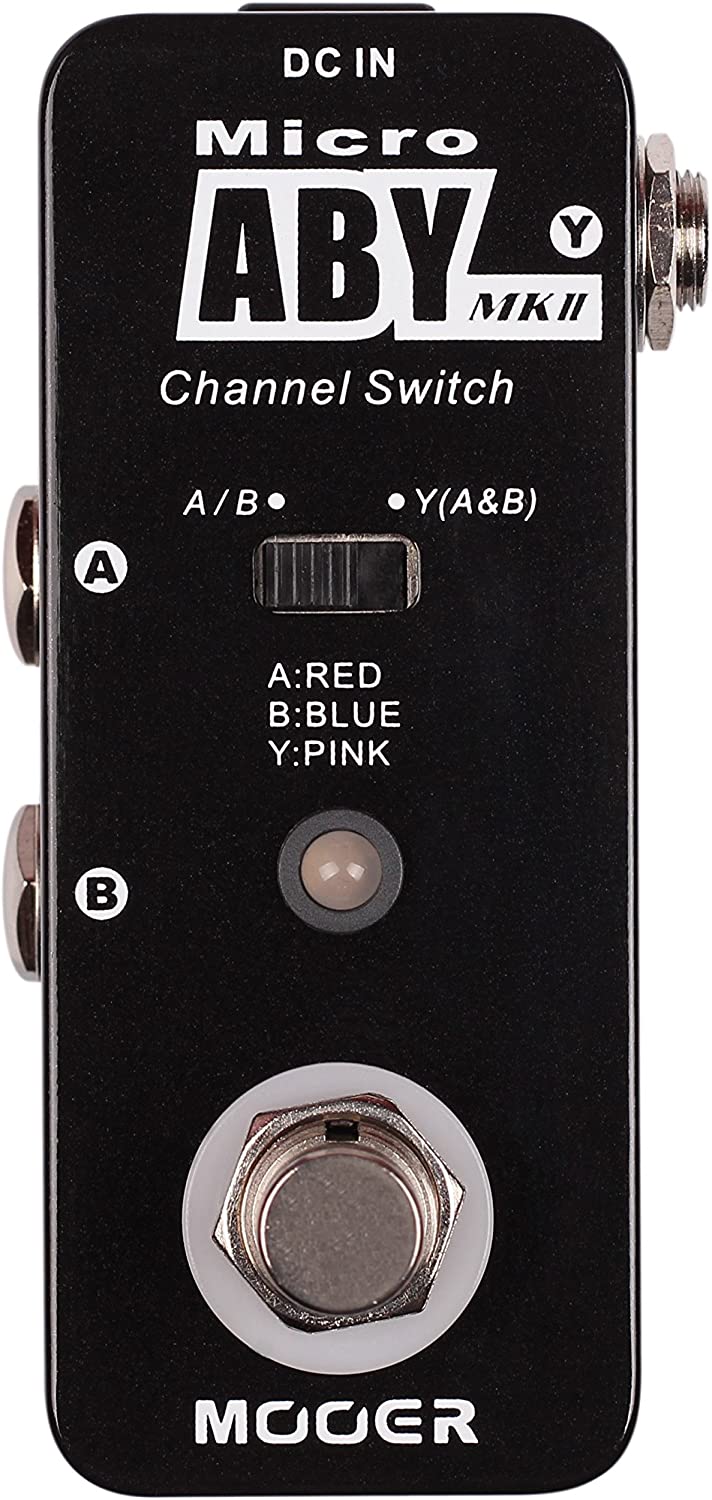
The MOOER Micro ABY MKII is a versatile channel switch pedal for guitarists.
It allows you to switch a one-way signal to two different outputs, making it perfect for use with instrument circuits, amplifiers, speaker cables, and pedalboards.
The pedal features a mode-choosing switch, making it possible to transfer between A and B channels simultaneously or individually in both positive and negative directions.
This compact, sturdy, and reliable pedal operates on 9 volts and 300 milliamps of power, making it a sought-after choice for musicians.
The Micro ABY also offers true bypass when not in use, ensuring your effects pedals stay unaffected by its presence in your chain.
With this channel switch pedal, guitarists can experience flexibility in their signal routing and enjoy the convenience of playing in various settings and environments.
Note that this pedal can function without a power supply, though the LED will not be illuminated in this scenario.
- My Review
First off, I have to say that the MOOER Micro ABY MKII Channel Switch Pedal is a genuinely impressive piece of gear.
It offered exactly what I needed to switch a single signal to two outputs.
Its versatility is perfect for my needs as a guitar player, making it an essential part of my setup for both practice and gigs.
Although the pedal can function without a power supply, I found it beneficial to use one for the added convenience of the LED indicator.
This feature made it easier to see the pedal’s status in low-light situations, often occurring on stage during performances.
The mode-choosing switch is a standout feature, allowing for easy transfer between A and B channels.
This flexibility enabled me to route my signal in various ways that suited my playing needs.
However, while it works well for home practice and quiet environments, I noticed some signals bleed from one amp to another when playing loud or during live performances.
This issue wasn’t a deal-breaker, but it’s worth considering if you play in a more professional setting.
The true bypass functionality was much appreciated since the MOOER Micro ABY MKII did not affect my other pedals.
I also appreciated using this pedal as a clean boost, adding extra punch to my signal when needed.
As for the build quality, the pedal’s compact and sturdy design made it easy to fit on my pedalboard without taking up too much space.
While some users might experience the occasional hiccup, such as slight tempo issues or unwanted noise, I found that the positives significantly outweighed the negatives in my experience.
Here are the ratings I’ll give to the MOOER Micro ABY MKII Channel Switch Pedal:
In my opinion, the MOOER Micro AB Overall, this pedal is a reliable and versatile addition to any guitarist’s setup.
It provides convenience, flexibility, and bonus features like the clean boost option, making it a worthy investment.
- Pros:
- Compact design
- Can switch signal to two different outputs
- Works without power supply
- Good sound quality
- Versatile for guitar and bass
- Cons:
- Potential noise and hum issues
- Some users experienced sound quality issues
- Limited tone control
- May not work well with certain effects
- Not suitable for live performances or gigs
My final verdict is that the MOOER Micro ABY MKII Channel Switch Pedal offers a compact and versatile solution for musicians switching their signal between two outputs.
With generally positive reviews highlighting its convenience, sound quality, and functionality as a headphone amp, it presents a useful tool for practice sessions and small setups.
However, some users have reported potential noise issues, limited tone control, and inconsistencies with certain effects.
Considering its overall features, brand reputation, and value, this pedal can be valuable to a guitarist’s or bassist’s arsenal, especially for home use or quiet rehearsals.
What exactly is an ABY pedal?
An ABY pedal called an AB/Y pedal or an A/B/Y switch, is a pedal device often used by guitarists and other musicians to control the signal routing of their instruments.
It essentially serves as a switch that allows the player to route their instrument’s signal to one of two separate output destinations (A and B) or both destinations simultaneously (Y).
This can enable a variety of creative signal routing options, giving the musician a greater degree of control over their sound.
This discussion will delve into an ABY pedal’s functionality, purpose, and applications within a musician’s setup.
An ABY pedal consists mainly of a metal or plastic housing containing electronic signal routing and switching components.
On the exterior of the pedal, there are typically three input/output jacks: one input for connecting the instrument and two outputs designated as A and B.
The pedal also has one or more footswitches that the musician engages using their feet.
These switches control the routing of the signal through the device, enabling the signal to be sent to output A, output B, or both outputs, depending on the configuration selected.

Let’s consider the core functionality of an ABY pedal.
For instance, when connected to an electric guitar, the guitar’s signal enters the input jack on the pedal.
This signal can then be directed simultaneously to outputs A, B, or both.
When the signal is sent to output A, any effects or amplifiers connected to output A will receive the guitar signal, while output B remains unaffected.
Similarly, only the effects or amplifiers connected to output B will receive the guitar signal if the signal is sent to output B.
Using the Y configuration, the guitar signal is split and sent to outputs A and B simultaneously, allowing the musician to engage two separate signal chains concurrently.
One of the main reasons musicians employ an ABY pedal is to facilitate seamless switching between two different amplifiers or sets of effects.
For example, a guitarist may have one amplifier set up with a clean tone for rhythm playing and another with a high-gain tone for lead playing.
Using an ABY pedal, the musician can quickly and effortlessly switch between the two amplifiers without unplugging and replugging cables.
Another application for an ABY pedal lies in the realm of effects processing.
Some guitarists may run different sets of effects pedals in parallel rather than in series, which is more common.
An ABY pedal can help to achieve this by allowing the musician to route their guitar signal to two separate effect chains, which can then be blended or used individually.
This can offer many tonal and textural possibilities that may not be achievable using a traditional single signal chain.
Moreover, an ABY pedal can also be combined with effects loops on guitar amplifiers.
Many amplifiers come equipped with effects loops, which enable the player to insert effects such as delays and reverbs in a specific part of the amplifier’s signal chain, usually between the preamp and power amp sections.
By connecting an ABY pedal to the effects send and return jacks of two separate amplifiers, the musician can toggle between the effects loops of both amplifiers or run them concurrently.
An important aspect to consider when using an ABY pedal is the issue of phase and grounding.
As the ABY pedal simultaneously sends the same instrument signal to different outputs, there is potential for phase cancellation or ground loop issues to arise.
Phase cancellation occurs when two copies of the same waveform are out of phase with each other, causing certain frequencies to be nullified or diminished.
To combat this issue, some high-quality ABY pedals come equipped with a phase reversal switch, allowing the user to flip the phase of one output relative to the other.
Similarly, ground loop issues can arise when the two output devices, often guitar amplifiers, have different ground potentials.
This can result in a hum or buzz in the audio signal.
To address this, many ABY pedals have a ground lift switch that can isolate the grounds of the two outputs, helping to eliminate unwanted noise while preserving the audio signal’s integrity.
What should you consider when choosing an ABY pedal?
As a guitarist, choosing the right ABY pedal for your rig can be crucial for seamless switching between amplifiers and signal routing.
With so many options on the market, weighing several factors to find the perfect fit for your desired sound and performance needs is essential.
– Sound quality
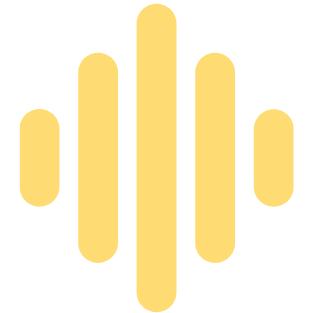
Sound quality plays a significant role in determining the effectiveness of an ABY pedal in your guitar setup.
It is essential that the pedal you choose maintains the integrity of your signal and does not introduce unwanted noise or distortion into your audio chain.
A transparent and noise-free performance is crucial for any guitarist who wants to achieve a clear and desirable sound.
One way to achieve excellent sound quality is to look for a pedal with true bypass technology or buffered bypass options.
True bypass provides a direct signal path when the pedal is disengaged, ensuring that your original guitar tone remains unaltered and unaffected by the ABY pedal.
This feature is particularly useful for guitarists who are particular about their tone and those who use numerous effects pedals in their setup.

On the other hand, buffered bypass can offer different benefits.
This feature becomes vital when using long cable runs, as it maintains the strength and quality of your signal even when traveling over significant distances.
Buffered bypass circuits actively drive the signal, preserving the frequency response and compensating for the loss of high frequencies that can occur with extended cable lengths.
This feature is especially useful for guitarists with complex pedalboard setups or during live performances where long cables are necessary.
– Controls and features

The simplest form of an ABY pedal may only provide the basic functionality of switching between two amplifiers.
However, more advanced models on the market offer a range of routing options that could be crucial for your setup.
For example, some ABY pedals can reverse the phase or apply a ground lift switch.
These features are particularly important for encountering ground loops or phase cancellation issues in your audio setup.
Addressing these issues can dramatically improve your sound quality and performance.
Additionally, many ABY pedals on the market offer extra features that greatly enhance your playing experience.
These can include dedicated tuner outputs, which allow you to connect your tuner directly to the pedal for accurate tuning in all situations.
Boost functions are another valuable addition, as they can increase your signal level, which can benefit solos or passages where you need more volume.
Built-in effects loops are yet another feature that some ABY pedals offer.
These loops provide the ability to integrate your effects chain into the pedal and maintain a clean signal path when switching between amplifiers.
With this flexibility, you can use different effects for each amplifier or blend them seamlessly to create unique tones.
– Analog vs. digital
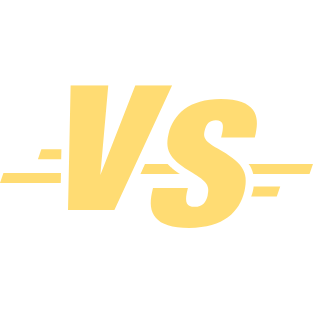
Analog pedals are revered for their warm, natural, and organic sound, often preferred among guitarists seeking a vintage tone.
Due to their timeless appeal and audio quality, these pedals have been the go-to choice for many musicians.
On the other hand, digital ABY pedals bring a broader range of possibilities to the table.
They frequently offer more connectivity options, such as multiple routing options and integration with other digital devices.
Their advanced switching capabilities allow guitarists to easily switch between various signal paths, granting enhanced control over their sound.
Digital pedals may also have additional features, such as built-in effects loops or MIDI compatibility, appealing to guitarists looking to integrate several different effects or devices within their setup.

While the primary purpose of an ABY pedal is to enable users to switch between their amplifiers or route their signal to achieve different combinations, the analog and digital offerings diverge in their approach to achieving this goal.
Those who lean towards a more classic, authentic sound may gravitate towards analog pedals, which can warm the tone many musicians adore.
However, digital ABY pedals might be more suitable for the modern guitarist seeking top-of-the-line versatility or a seamless fit within their digital ecosystem.
Ultimately, the choice between analog and digital ABY pedals will depend on an individual’s preferences for tone, versatility, and future-proofing of their rig.
– Build quality and durability.

ABY pedals that are well-constructed and built to withstand the rigors of regular use are essential for professional musicians who need reliable gear for studio work, gigs, or touring.
Look for a pedal with heavy-duty metal housing, robust switch mechanisms, and high-quality input/output jacks.
Additionally, consider the size and weight of the pedal, as it will have to fit on your pedalboard and be easy to transport.
Presets and versatility
Some musicians rely solely on a simple amp-switching functionality, whereas others demand a more versatile unit to manage complex signal routing and integrate with their pedalboard setup effortlessly.
An ABY pedal with preset storage or programmable capabilities is convenient for many guitarists.
This feature allows them to quickly and easily recall custom settings whenever necessary.
This flexibility is invaluable for musicians who regularly modify their preferred signal routing arrangements, as it eliminates the need for repeated manual adjustments.
By investing in an ABY pedal that offers presets and enhanced versatility, guitarists can streamline their performance and ensure a smooth transition between various routing configurations, enhancing their overall playing experience.
– Brand reputation

When choosing an ABY pedal, the manufacturer’s reputation should be considered.
Established and well-respected brands are more likely to produce high-quality, reliable pedals that have been thoroughly tested and refined over time.
Research the credentials and history of the brand, and consider their other product offerings, as this may give you a good indication of the quality and performance you can expect.

– Price and budget
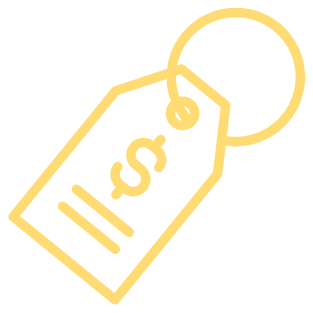
Your budget will inevitably affect your decision-making process when selecting an ABY pedal.
It’s essential to balance quality and features against the pedal’s cost.
While higher-priced pedals generally offer better build quality, more features, and enhanced sound quality, affordable options still deliver excellent performance and reliability.
Determine your budget and prioritize the factors most important to you before purchasing.
– Reviews and recommendations

Reading customer reviews and obtaining recommendations from fellow musicians or online forums is a valuable resource when considering the purchase of any guitar-related gear.
By hearing about personal experiences with specific ABY pedals, you can gain insights into the pros and cons of each option and discover lesser-known yet impressive products.
Always take your own specific needs into account when weighing the advice and opinions of others.
How to properly use an ABY pedal?
An ABY pedal can be a game-changer if you’re a musician who frequently switches between multiple instruments or amplifiers on stage.
However, it is important to know how to properly use this versatile pedal to avoid sound quality issues and maximize its potential.
– Familiarize yourself with the controls and features
An ABY pedal allows a musician to switch or combine two separate signal paths, typically between two amplifiers or two guitars.
Before using an ABY pedal, becoming familiar with its controls and features is crucial.
Most ABY pedals have a few fundamental buttons and switches, such as input/output jacks, LED indicators, and usually two footswitches.
One switch toggles between outputs A and B, while the other switches to A and B simultaneously.
Some advanced models might have additional controls like phase inversion or ground lift switches.
– Adjust the parameters to suit your musical goals
Consider how you want to use it in your music setup to get the most out of your ABY pedal.
Are you switching between two different amplifiers that have unique tones?
Or are you adding versatility to your signal chain by toggling between two guitars?
Understanding your musical goals will help you adjust the parameters of the ABY pedal to suit your specific needs and enhance your performance.
– Incorporate the ABY pedal into your signal chain
Consider its placement when integrating the ABY pedal into your existing signal chain.
While placement can vary depending on your specific gear and preferences, placing the ABY pedal close to the end of your signal chain before your final amplifier is typically best.
This way, you can still have the ability to switch between different amplifiers without affecting other effects in your signal chain.
– Calibrate the volume and tone settings on each amplifier
After incorporating the ABY pedal into your signal chain, it’s crucial to take the time to calibrate the volume and tone settings on each of your amplifiers to ensure that you’re able to achieve the desired balance in your sound.
This process might involve setting one of the amps to produce a clean tone while setting the other up to produce a distorted tone, allowing you to switch between two distinct sounds during a performance.
Another approach would be to carefully tweak both amplifiers’ volume and EQ levels to create a perfectly balanced sound when you switch between them.
When toggling between the amplifiers using the ABY pedal, it’s essential to experiment with these settings and adjustments to arrive at a coherent and satisfying sound.
Moreover, when calibrating the volume and tone settings, consider how your ABY pedal interacts with both amplifiers and try to understand how the pedal’s settings might affect the overall sound output.
This can help refine the resulting audio and ensure the ABY pedal performs optimally in your setup.
It’s worth noting that achieving the perfect balance may take some experimentation and patience to fine-tune the settings for your specific rig.
Setting aside ample time for this process will result in a more rewarding performance experience, seamlessly transitioning between amplifiers while maintaining a consistent and dynamic sound.
– Test the ABY pedal in various performance scenarios
Testing the ABY pedal in various performance scenarios before using it for a live performance or recording session is crucial to ensure it responds as expected.
By doing so, you can better understand how the pedal interacts with different amplifiers and how the signal chain elements complement each other.
Taking the time to practice switching between amplifiers helps familiarize yourself with each setup’s intricacies, allowing you to transition during live performances seamlessly.
Incorporating different guitars and effects into your signal chain also plays a significant role in understanding the full capabilities of your ABY pedal.
This experimentation provides insight into how various guitars and effects may alter the overall tone and dynamics when using the pedal.
Furthermore, exploring different settings on your ABY pedal can help uncover unique tonal options and optimal configurations for your specific needs.
– Consider using a buffered ABY pedal
A crucial aspect to consider when selecting an ABY pedal for your musical setup is whether to opt for a passive or a buffered ABY pedal.
While passive ABY pedals can work well in most situations and are generally more affordable, there are specific cases where a buffered ABY pedal might be a superior choice.
The main advantage of buffered pedals is that they help maintain your guitar’s tone and volume by eliminating signal loss over extended cable runs.
This feature offers the benefits of isolated output, ensuring a stable and consistent sound quality throughout your performance.
You might experience signal degradation or noise when using a passive ABY pedal, especially if your setup involves long cable runs or several other effects pedals in your signal chain.
In such scenarios, investing in a buffered ABY model could significantly improve your sound quality and overall performance experience.
Buffered pedals maintain the integrity of your guitar’s signal and minimize potential noise interference caused by other devices in your setup.
– Maintain and troubleshoot your ABY pedal:

Regular maintenance of your ABY pedal is key to ensuring it operates at peak performance.
This includes cleaning input and output jacks, regularly checking for loose connections, and addressing any possible performance issues.
Start noticing any issues with your ABY pedal, such as inconsistent switching or signal loss.
It may be time to troubleshoot potential problems or consider upgrading to a more reliable model.
How to order pedals on a pedalboard?
There is no one-size-fits-all approach to ordering pedals on a pedalboard, as the optimal arrangement largely depends on the specific sound you’re aiming for.
Usually, though, you will see guitar players mostly agreeing with this order:
Tuner > Filters/Dynamics > Pitch-based Effects > Overdrive/Distortion > Modulation > Time-based Effects > Looper
Aside from that, some general guidelines can help you achieve a balanced and versatile setup.
Let’s talk in detail about the order we just mentioned, but feel free to experiment and adjust to your own preferences:
- Tuner: Place your tuner pedal first to ensure your signal is in tune before passing through the other pedals.
- Filters and dynamics: Wah-wah, envelope filters, compressors, EQs, and noise gates should come next. These pedals affect your sound’s dynamic and tonal aspects, so it’s best to place them early in the chain.
- Pitch-based effects: Octavers, harmonizers, and pitch shifters should come after filters and dynamics since these pedals alter the pitch of your signal and work best with a clean, unprocessed sound.
- Overdrive and distortion: Overdrive, distortion, and fuzz pedals typically come next. They shape your guitar’s core sound, and placing them before most other effects ensures that those effects receive a strong, consistent signal.
- Modulation effects: Chorus, flanger, phaser, and tremolo pedals should be placed after overdrive and distortion effects. We do this to allow these pedals to add depth and movement to your sound without becoming overly distorted or overbearing.
- Time-based effects: Delay and reverb pedals should be placed towards the end of your signal chain. This allows them to create a sense of space and depth around the other effects, simulating the sound of a room or hall.
- Looper: If you use a looper pedal, it should be placed last in the chain. This ensures that you’re looping the entire signal, including all the effects you’ve applied.
Remember, these are just general guidelines and what generally works and sounds good.
The most important thing is to experiment and find the arrangement that best suits your personal sound and style.
For example, here’s one pedalboard signal chain that I always use:
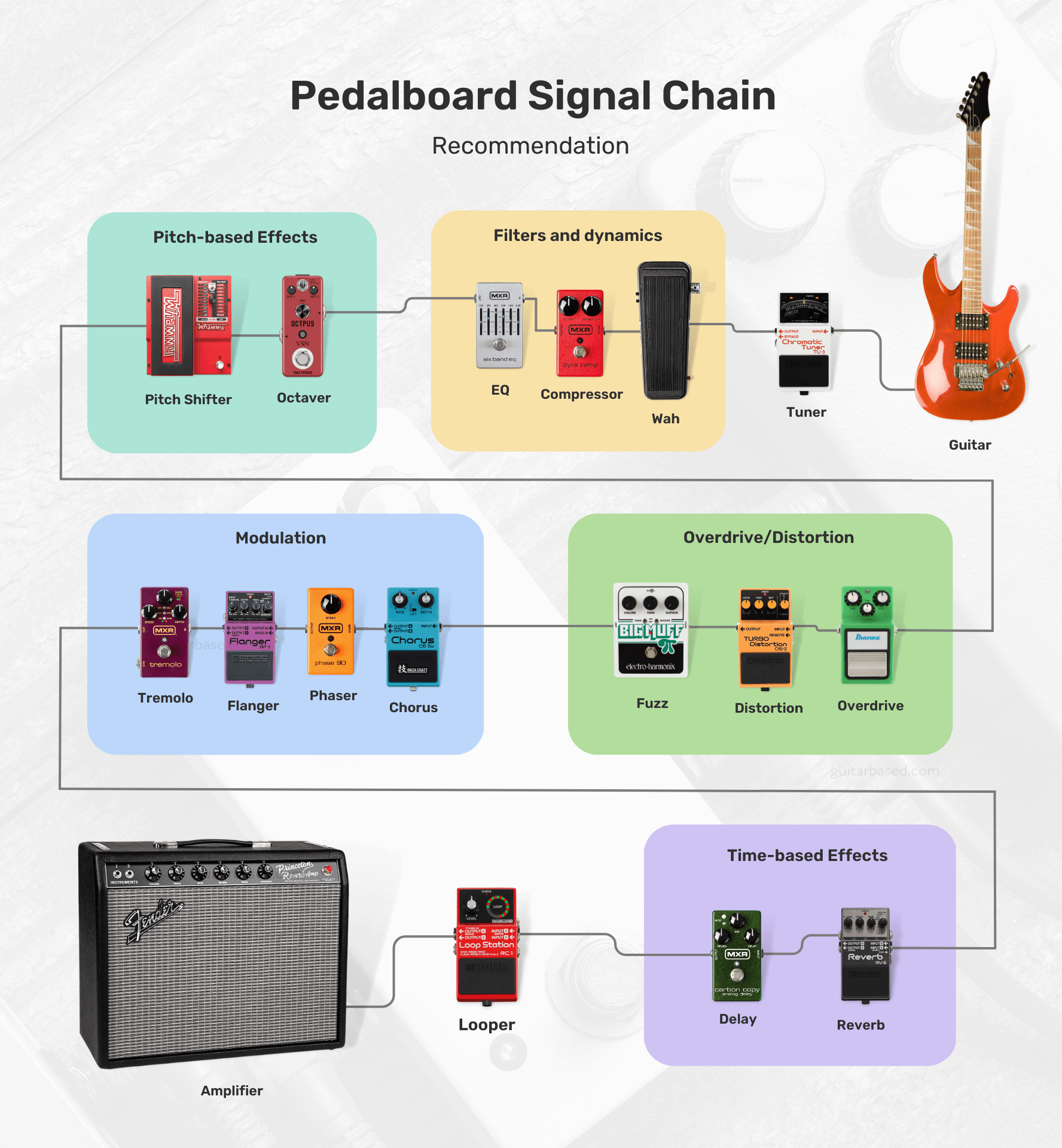
Feel free to swap the order of pedals, try different combinations, and test out unconventional setups until you find the one that works best for you.
For those interested, I’ll leave you with most of the possibilities that you’ll encounter and how to order them.
- Tuner
- Filters/Dynamics:
- Volume
- Wah
- Auto-Wah
- Compressor
- Noise Gate
- EQ (Equalizer)
- Pitch-based Effects:
- Octaver
- Harmonizer
- Pitch Shifter
- Overdrive/Distortion/Fuzz:
- Boost
- Overdrive
- Distortion
- Fuzz
- Modulation:
- Chorus
- Phaser
- Flanger
- Univibe
- Vibrato
- Tremolo
- Time-based Effects:
- Delay
- Echo
- Reverb
- Synth/Bitcrusher:
- Synth
- Bitcrusher
- Acoustic Simulator
- Multi-Effects
- Utility:
- Buffer
- A/B/Y Switcher
- MIDI Controllers
- Looper
Boutique vs. Mass-Produced pedals
Boutique pedals are generally built with higher-quality components and craftsmanship, resulting in better durability and longevity.
These pedals often feature unique and innovative designs, providing a wider range of tones and effects that may not be available in mass-produced options.
Here are a few examples of boutique pedals:

All the manufacturers also tend to have a more personal approach, with better customer service and the ability to customize pedals according to the user’s preferences.
However, boutique pedals are usually more expensive due to the smaller scale of production and the use of premium components.
Mass-produced pedals, on the other hand, are more affordable due to their larger scale of production and the use of cost-effective components.
These pedals are widely available and offer a range of popular effects, making them accessible to a larger audience.
Here are a few examples of mass-produced pedals:

The quality control for mass-produced pedals can vary depending on the brand and model, but many are reliable and offer good value for the money.
As for one of the downsides, you’ll find that mass-produced pedals may not have the same level of uniqueness or innovation as boutique options.
On the other hand, they may not provide the same level of customer service or customization options.
The choice between boutique and mass-produced pedals depends on your personal preferences, budget, and desired sound.
If you’re looking for unique tones, higher-quality components, and a more personal experience, boutique pedals may be the way to go.
But I would say, for those who are on a budget and need access to popular effects, mass-produced pedals might be a better fit.
It’s worth trying out both types to see which best suits your needs and playing style.
How much should you spend on a guitar pedal?
If I were in your position, I would first determine my budget and specific needs before deciding how much to spend on a guitar pedal.
For beginners, it might be more reasonable to start with affordable, mass-produced pedals to explore different effects without spending too much.
Guitar pedals can range in price from around $30 to over $400, depending on the brand, quality, and complexity of the effect.
As your skills and understanding of your preferred tone develop, you can gradually upgrade to higher-quality or boutique pedals.
One thing I would do is consider which effects are essential to your playing style and prioritize purchasing those first.
Allocating a larger portion of your budget to the most important pedals might be a wise choice, especially if you only need a few basic effects.
However, if you require a wide array of effects, you may want to consider more budget-friendly options or multi-effects units.
Keep in mind that higher-priced pedals often come with better build quality, unique features, and improved sound quality.
But I would also say that price is not always directly correlated with quality or suitability for your needs.
Sometimes, a more affordable pedal can deliver the exact sound you’re looking for, while a higher-priced option might not meet your expectations and are only expensive because of the brand reputation.
Can you use a guitar pedal with a bass guitar?
You can certainly use a guitar pedal with a bass guitar.
But it’s crucial to be aware that some guitar pedals may not be specifically designed to accommodate the frequency range of a bass guitar.
This could result in a less-than-ideal performance or an altered tone that might not be what you were expecting.
If you’re feeling adventurous and eager to experiment with your sound, don’t hesitate to connect your guitar pedals to your bass guitar.
This can be a fun way to explore different sonic possibilities, and you might even stumble upon some unique tones that complement your playing style perfectly.
Using a guitar pedal with a bass guitar may not always produce the desired results.
In some cases, the low-end frequencies might be lost, or the effect could sound too harsh or muddy.
To avoid these issues, you could consider looking into pedals that are specifically designed for bass guitars.
These pedals are engineered with the bass frequency range in mind, ensuring that your low-end remains intact and the effect sounds as intended.
In addition to bass-specific pedals, there are also multi-effects processors and pedals that cater to both guitar and bass players, offering a wide range of effects and tonal options.
These versatile units can be a great solution if you play both instruments and want a single device to cover your needs.
How to properly power your pedals?
When it comes to powering your pedals, you want to make sure you’re doing it right to avoid any noise issues or potential damage.
First, check each pedal’s power requirements, which you can usually find in the manual or on the pedal itself.
You’ll want to pay attention to the voltage (usually 9V, 12V, or 18V) and current (measured in milliamps or mA).
Now, you’ve got a few options for powering your pedals.
You can use individual power supplies or batteries for each pedal, but that can get messy and inconvenient.
I’d recommend going for a pedal power supply or an isolated power brick.

For example here are a few ones I recommend:
- Voodoo Lab Pedal Power 2 Plus Isolated Power Supply (My favorite)
- Rowin PW-1 Guitar Pedal Power Supply (Cheapest)
These babies can power multiple pedals at once, and the isolated outputs help prevent noise and ground loop issues.
Just make sure the power supply you choose can handle the voltage and current requirements of all your pedals.
When you’re connecting everything, use good quality power cables and keep them neat and tidy to avoid a tangled mess.
You might even want to use cable ties or cable organizers to keep everything in order.
In love with guitars, and gear; expert in all things music! Been writing about guitars for about 5 years and counting. Born in the ’90s. Alma Mater: University of Havana. Always curious, trying to understand the world. #TeamFender

